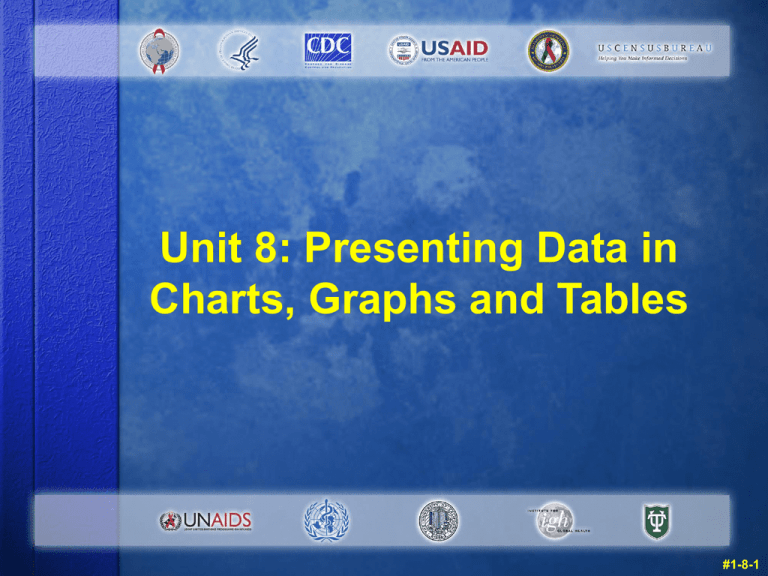
Unit 8: Presenting Data in
Charts, Graphs and Tables
#1-8-1
Warm Up Questions: Instructions
Take five minutes now to try the Unit 8 warm
up questions in your manual.
Please do not compare answers with other
participants.
Your answers will not be collected or graded.
We will review your answers at the end of the
unit.
#1-8-2
What You Will Learn
By the end of this unit you should be able to:
list the variables for analysing surveillance
data
identify the types of charts and graphs and
when the use of each is appropriate
#1-8-3
Analysing Surveillance Data
Person: Who develops a disease (for example, by
age group or sex)? Are the distributions changing
over time?
Place: Where are cases occurring? Is the
geographical distribution changing over time?
Time: Is the number of reported cases changing
over time?
#1-8-4
Purpose of Displaying Data
The purpose of developing clearly
understandable tables, charts and graphs is
to facilitate:
analysis of data
interpretation of data
effective, rapid communication on complex
issues and situations
#1-8-5
Types of Variables
Categorical variables refer to items that can
be grouped into categories.
Ordinal variables are those that have a natural
order.
Nominal variables represent discrete categories
without a natural order.
Dichotomous variables have only two
categories
Continuous variables are items that occur in
numerical order.
#1-8-6
General Rules for Displaying Data
Simpler is better.
Graphs, tables and charts can be used together.
Use clear descriptive titles and labels.
Provide a narrative description of the highlights.
Don’t compare variables with different scales of
magnitude.
#1-8-7
Graphs
A diagram shown as a series of one or more
points, lines, line segments, curves or areas
Represents variation of a variable in comparison
with that of one or more other variables
#1-8-8
Scale Line Graph
Scale line graph: represents frequency
distributions over time
Y-axis represents frequency.
X-axis represents time.
#1-8-9
Example: Scale Line Graph
Figure 8.1. Trends in HIV prevalence among
pregnant women in Country X, years 1 – 10
40
30
% 20
10
Year
0
1991
1992
1993
1994
1995
1996
1997
1998
1999
2000
Source: STD/AIDS Control Programme, Uganda (2001) HIV/AIDS Surveillance Report
#1-8-10
Specific Rules: Scale Line Graphs
Y-axis should be shorter than X-axis
Start the Y-axis with zero
Determine the range of values needed
Select an interval size
#1-8-11
Bar Charts
Uses differently coloured or patterned bars to
represent different classes
Y-axis represents frequency
X-axis may represent time or different classes
#1-8-12
Example: Bar Chart
Figure 8.2. Differences in HIV prevalence among
various high-risk groups, Country X, year 1.
% H IV p rev alen ce
30
25
20
15
10
5
0
F em ale s ex
M en w ho
Injec ting drug
w ork ers
have s ex
us ers
P ris oners
R efugees
w ith m en
P o p u la tio n
#1-8-13
Specific Rules: Bar Charts
Arrange categories that define bars in a natural
order (for example, age).
If natural order does not exist, define categories by
name, such as country, sex or marital status.
Position the bars either vertically or horizontally.
Make bars the same width.
Length of bars should be proportional to the
frequency of event.
#1-8-14
Clustered Bar Charts
Bars can be presented as clusters of
sub-groups in clustered bar charts.
These are useful to compare values
across categories.
They are sometimes called stacked bar
charts.
#1-8-15
Example: Clustered Bar Chart
HIV prevalence (%)
Figure 8.3. HIV prevalence rate among
pregnant 15- to 19-year-olds at 4 clinic
sites, City X, Country Y, years 1 – 3
Yea r 1
Yea r 2
Yea r 3
35
30
25
20
15
10
5
0
Site 1
Site 2
Site 3
Site 4
Clinic
Source : Ministry of Health, Count ry Y. Annual AIDS Surve illa nce Report, y ear 3.
#1-8-16
Specific Rules:
Clustered Bar Charts
Show no more than three sub-bars within a
group of bars.
Leave a space between adjacent groups of
bars.
Use different colours or patterns to show
different sub-groups for the variables being
shown.
Include a legend that interprets the different
colours and patterns.
#1-8-17
Histograms
A representation of a frequency distribution
by means of rectangles
Width of bars represents class intervals and
height represents corresponding frequency
#1-8-18
Example: Histogram
Figu8.4.
re 7.3.
Childr en
Living
HIV,
Figure
Children
living
withwith
HIV,
District X, 2002
District X, 2002
160
140
120
100
80
60
40
20
0
<1
1
2
3
4
5 -9
10 - 13
#1-8-19
Pie Charts
A circular (360 degree) graphic
representation
Compares subclasses or categories to the
whole class or category using differently
coloured or patterned segments
#1-8-20
Example: Pie Chart
Figure 8.5. Projected annual expenditure
requirements for HIV/AIDS care and support
by 2005, by region
#1-8-21
Area Maps
A graph used to plot variables by geographic
locations
#1-8-22
Example: Area Map
Figure 8.6. HIV Prevalence in Adults
in Africa, end 2003
Source: UNAIDS, 2003
#1-8-23
Tables
A rectangular arrangement of data in which
the data are positioned in rows and columns.
Each row and column should be labelled.
Rows and columns with totals should be
shown in the last row or in the right-hand
column.
#1-8-24
Example: Table
Table 8.1. Adults and children with HIV/AIDS
by region in Country Y, end year X
Region
Adults and adolescents ≥ 15
years
Children <15 years
Total
1
14 800
200
15 000
2
400 000
20 000
420 000
3
997 000
3 000
1 000 000
4
985 000
15 000
1 000 000
5
1 460 000
40 000
1 500 000
6
465 000
35 000
500 000
7
940 000
10 000
950 000
8
380 000
220 000
600 000
9
900 000
600 000
1 500 000
10
545 000
5 000
550 000
7 086 800
948 200
8 035 000
Total
#1-8-25
In Summary
Surveillance data can be analysed by person,
place or time.
Depending on your data, you can choose
from a variety of chart and graph formats,
including pie charts, histograms, tables, etc.
Using several simpler graphics is more
effective than attempting to combine all of the
information into one figure.
#1-8-26
Warm Up Review
Take a few minutes now to look back at your
answers to the warm up questions at the
beginning of the unit.
Make any changes you want to.
We will discuss the questions and answers in
a few minutes.
#1-8-27
Answers to Warm Up Questions
1. List two demographic variables by which
surveillance data can be analysed.
#1-8-28
Answers to Warm Up Questions,
Cont.
1. List two demographic variables by which
surveillance data can be analysed. Age, sex,
marital status, etc.
#1-8-29
Answers to Warm Up Questions,
Cont.
2. True or false? Compiling all the data into one
comprehensive chart or graph is more
effective than including many simpler
diagrams.
#1-8-30
Answers to Warm Up Questions,
Cont.
2. True or false? Compiling all the data into one
comprehensive chart or graph is more
effective than including many simpler
diagrams. False
#1-8-31
Answers to Warm Up Questions,
Cont.
3. Which of the following cannot be extracted
from public health surveillance data:
a. changes over time
b. changes by geographic distribution
c. differences according to subject’s sex
d. none of the above
#1-8-32
Answers to Warm Up Questions,
Cont.
3. Which of the following can not be extracted
from public health surveillance data:
a. changes over time
b. changes by geographic distribution
c. differences according to subject’s sex
d. none of the above
#1-8-33
Answers to Warm Up Questions,
Cont.
4. Match the type of chart/graph with its
example.
#1-8-34
Answers to Warm Up Questions,
Cont.
4. Match the type of chart/graph with its
example:
scale line graph: d
area map: c
pie chart: a
histogram: b
#1-8-35
Small Group Discussion:
Instructions
Get into small groups to discuss these
questions.
Choose a speaker for your group who will
report back to the class.
#1-8-36
Small Group Reports
Select one member from your group to
present your answers.
Discuss with the rest of the class.
#1-8-37
Case Study: Instructions
Try this case study individually.
We’ll discuss the answers in class.
#1-8-38
Case Study Review
Follow along as we go over the case study in
class.
Discuss your answers with the rest of the
class.
#1-8-39
Questions, Process Check
Do you have any questions on the information
we just covered?
Are you happy with how we worked on Unit 8?
Do you want to try something different that will
help the group?
#1-8-40





